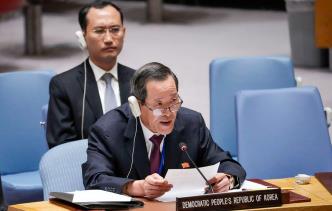
North Korea is continuing to escalate its confrontation with the growing alliance of countries around it. Backed by China and Russia, Pyongyang is once again building its nuclear and space capacity, as well as its rhetoric. But the threat environment is changing and a new wall to contain North Korean military activity is rising.
This wall is metaphorical of course, as it is made up of sensors, rockets and other technologies rather than bricks. The barrier is made up of various layers of defense armaments and sensor systems that aim to protect countries such as South Korea, Japan, the Philippines and even Taiwan. These are not all interoperable but the fact that the alignment is occurring is significant to Western Pacific Ocean security. To be sure, the escalation ladder in the Northeast Asia sector is rising and, likely regardless of what happens in Russia, will continue.
China does not like these technological linkages and advances and is implementing strategies to fracture or complicate the US/Western-backed relationships. Beijing is taking advantage of a political rift in South Korea, attempting to throw a wrench in its relationships with the US and Japan. It has aligned with South Korea’s opposition in an effort to sway public sentiment and prevent those three countries from moving closer together.
Relations between Japan and South Korea and security cooperation among Japan, South Korea and the US have greatly improved under Yoon Suk-yeol’s presidency in Seoul, but the progress could be reversed just as quickly. Importantly, South Korea"s new national security strategy highlights what it sees as the danger posed by Beijing’s diplomatic maneuvers. In a balancing act because of the nature of Northeast Asian politics, South Korea’s new national security strategy, which was released this month, said it would maintain relations with China “in a consistent and resolute manner, based on national interests and principles.”
But South Korea’s population mix and the sentiment toward North Korea among various Seoul-based interest groups complicates the social media environment. This fact gives Beijing leverage and the phenomenon is not static but growing. China knows that South Korea’s foreign policy, especially its stance toward China and North Korea, often shifts dramatically when a new president takes office, which happens every five years.
Much of what is driving North Korea’s foreign policy today is the aftermath of last month’s failed launch of the Malligyong-1 military intelligence rocket. Pieces of debris, believed to be the Chollima-1 rocket used for the mission, were recovered by South Korea’s navy this week — a huge embarrassment for the North Korean regime. Pyongyang said this event was the worst failure ever for the North Korean state and immediately began to escalate rhetoric about “nuclear war.” Much of this talk is just rhetoric, but Pyongyang needs to be taken very seriously because of the technological developments that keep it as a perennial global threat. Hence, closer US cooperation with Western Pacific states is important and evolutionary, while attempting to box in any potential threat.
Much of what is driving North Korea’s foreign policy today is the aftermath of last month’s failed rocket launch.
Dr. Theodore Karasik
In response, South Korea-US relations are becoming closer and more integrated than ever before. North Korea’s anger at the rocket failure is based on the fact that Seoul and Washington in April signed the Washington Declaration, in which the two countries committed to engaging in deeper dialogue and information-sharing efforts via a new nuclear consultative group aimed at strengthening nuclear deterrence efforts on the Korean Peninsula.
The Washington Declaration focuses on expanding intra-alliance consultations on nuclear weapon matters and further integrates the forces of the US and South Korea in ways that can limit unintended escalation and buttress deterrence, as part of the larger conceptual aspect of building a wall against nuclear use. The integration of South Korean military capabilities into US nuclear strategy is part of the current security milieu. This activity mirrors NATO’s nuclear planning.
Meanwhile, in the overall military sphere, the Washington Declaration also calls for closely connecting the capabilities and planning activities of Seoul’s new strategic command and the two countries’ Combined Forces Command. As South Korea’s conventional deterrence capabilities grow ever more advanced and capable, ensuring intra-alliance integration will be key.
The thinking is to take this model and apply the same template to other pro-US allies in the Pacific Ocean region, while recognizing the sensitivities of this topic to local parties and interest groups in Japan, the Philippines and Taiwan. But the road is long and negotiations will be necessary, but not impossible. The long-term outlook is to create a network of allies that are as unified as possible using high-tech, interoperable measures for both nuclear and conventional warfare scenarios.
Overall, the security situation in Northeast Asia is evolving into an escalating standoff in a changing geostrategic environment. What happens next in Russia matters globally and North Korea fully supports Moscow. China-Russia relations are also stable and likely to grow stronger in the coming months as various theaters heat up. While the Gulf region itself may be de-escalating, there is no doubt that the Western Pacific could become as hot as the Ukrainian-Russian battlefield.
• Dr. Theodore Karasik is a senior adviser to Gulf State Analytics in Washington.
Twitter: @KarasikTheodore












